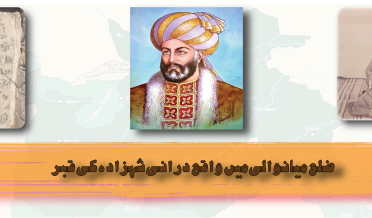======================================
Mir Chakar Rind : separating fiction from history
By Barmazid
Mir Chakar Rind is referred to as “King of Baluchistan” and epithet of “the great” is attached to
his name in some of the modern writings. However, a careful study of history shows that Chakar
Rind was no king, and, legends and fictions are being masqueraded as history. Even going by the
Baloch legends and folklore, Chakar Rind appears to be merely a tribal chieftain and he was no
more powerful than the chief of Lashari tribe whom he could not defeat in a tribal war, spanning
30 years.[1]
If Baloch legends and folklore are to be believed and taken seriously, Chakar Rind joined
Humayun with 40 thousands Rinds and won the Delhi throne for the Mughal king [2]. This is not
supported by any historical evidence. Gulbadan Begum and Jauhar Aftabchi, who accompanied
Humayun and have written eye-witness accounts, have not mentioned Chakar Rind at all. Abu
Fazal of Akbar’s court, also did not notice him. It shows that Chakar Rind was a nobody and an
unimportant person to Humayun.
According to Baloch ballads recorded by Longworth Dames, Mir Chakar and his men fought
Turks at Delhi [3]. We find, however, from authentic history, that Humayun wrested Delhi from
Afghans in 1555. In another Baloch ballad recorded by by Longworth Dames, Chakar Rind is
shown to be rather at war with Mughal king emperor Humayun [4]. These legends are not
corroborated by Mughal sources.
Who was the historical Chakar Rind?. According to Tabaqat-i-Akbari by Khawaj Nizamuddin
Ahmad (complied in 1593-94), Mir Chakar Rind came to Multan from the neighborhood of Siwi
(Sibi) with his two sons Mir Allahdad and Mir Shahdad in the early years of 16th century. Chakar
Rind tried to enter the service of the Sultan Mahmud Langah of Multan but failed as Malik
Sohrab Dodai, a favourite noble of the Langah Sultan, opposed him. Chakar Rind left Multan and
sought the protection of Jam Bayazid Sammah of Shortkot (in modern Jhang district, Punjab), a
former wazir of the Langah Sultans who had sworn fealty to Sultan Sikandar Lodi. Jam Bayazid
bestowed a jagir on him (which was most probably Satgarah). The relevant passage in Tabaqat-iAkbari reads as follows :
“About this time Mir Jakar Zand (read “Mir Chakar Rind”) came to Multan from the
direction of Sewi with his two sons Mir Allahdad and Mir Shahdad. Mir Shahdad was
the first man who promulgated the Shia religion in Multan. As Malik Suhrab Dudai
was held in great honour by the Lankahs (read “Langahs”), Mir Chakar Rind couldnot remain there; and sought an asylum with Jam Bayazid. As he was the head of a
clan, Jam Bayazid received him with much honour, and bestowed on him and his
sons a part of the territory which was in the Khalsa or crown land.” [5]
Thus we come to know that Mir Chakar Rind was merely a jagirdar in the service of Jam Bayazid
during the reign of Sultan Sikandar Lodi. The author of Tabaqat-i-Akbari describes him as the
head of a clan rather than former king of a kingdom.
Mir Chakar Rind is also mentioned in “Tuhfa-i-Akbarshahi” , a biography of Sher Shah Sur
compiled in circa 1580 AD by Abbas Khan Sarwani at the orders of Mughal emperor Akbar. That
source informs us that Chakar Rind was merely an administrator of the town and pargana of
Satgarha (located in modern Okara district of Punjab) in 1540s on behalf of Sher Shah Sur.
Haibat Khan Niazi, the Sher Shah’s governor of the Punjab, once paid a visit to Chakar Rind. The
latter became nervous due to lack of preparation time. The relevant passage in Tuhfa-iAkbarshahi reads as follows :
“When Sher Shah had laid siege to the fort of Raisin, he received a letter from
Khawwas khan saying that he and Niazi had developed some differences between
themselves.” The letter contained a request that Sher Shah should, therefore ,
summon one of the two. Having gone through the letters of Khawwas , Sher Shah
summoned Khawwas Khan, Isa Khan Niazi and Habeeb khan. Then he conferred the
country of Punjab on Haibat Khan Niazi and ordered him to rescue and rehabilitate
Multan which had been usurped by the Balochs. He was also to chastise Fateh Khan
Jat of Qabula, who had been, during the Mughal period, laying waste to the country
up to Panipat. As soon as Haibat khan received these orders , he summoned the
representative of Chakar Rind, The hakim of Satgarah. The representative was told
to go and inform Chakar Rind that Haibat khan Niazi was going to tour those areas.
Chakar should be prepared to present his contingent for review. One who related the
story that he had heard it from Wakil Fateh Khan Kanbo that when he went to
Chakar Rind and disclosed to him what Haibat Khan Niazi has said, the former was
thrown in panic, he had no time either to a reception or to put together the “lashkar”
as demanded. At this time Haibat Khan Niazi was merely two day’s distance away.
Next morning the news came that Haibat Khan Niazi had already arrived. Hearing
this, Chakar became nervous, although he did manage to get on his horse and to go
out to receive the dignity.” [6]
The above passage from Tuhfa-i-Akbarshahi reveals that Chakar Rind was far from being an
independent and mighty king of a vast kingdom. He was an ordinary subordinate of the governor
of Punjab and his jagir comprised of the pargana of Satgarha. We also find that he was far from
being a national hero in those years and he was operating against other Balochs on behalf of
Afghans. After that Chakar Rind disappear from the scene ; but he continued to hold his jagir at
Satghara and there died, and was buried.
References
1- “Journal of the Asiatic Society of Bengal”, Vol-49, Part 1, p-140
2- “Popular Poetry Of The Baloches” (1907), by M.Longworth Dames, Vol-1, p-32
3- Ibid, p-33
4- “Journal of the Asiatic Society of Bengal” (1880), Vol-49, Part 1, p-142
5- Tabaqat-i-Akbari”, translated into English by Brajendranath De, Volume III, pp.804-804.
6- “Afghans of the Frontier Passes: A Study in the Historical Geography of Sibi and Dhader in the
Balochistan Province of Pakistan” (1992), by A.Aziz Luni, Vol-1, p-86bove passage from Tuhfa-i-Akbarshahi reveals that Chakar Rind was far from being an
independent and mighty king of a vast kingdom. He was an ordinary subordinate of the governor
of Punjab and his jagir comprised of the pargana of Satgarha. We also find that he was far from
being a national hero in those years and he was operating against other Balochs on behalf of
Afghans. After that Chakar Rind disappear from the scene ; but he continued to hold his jagir at
Satghara and there died, and was buried.
References
1- “Journal of the Asiatic Society of Bengal”, Vol-49, Part 1, p-140
2- “Popular Poetry Of The Baloches” (1907), by M.Longworth Dames, Vol-1, p-32
3- Ibid, p-33
4- “Journal of the Asiatic Society of Bengal” (1880), Vol-49, Part 1, p-142
5- Tabaqat-i-Akbari”, translated into English by Brajendranath De, Volume III, pp.804-804.
6- “Afghans of the Frontier Passes: A Study in the Historical Geography of Sibi and Dhader in the Balochistan Province of Pakistan” (1992), by Aziz Luni, Vol-1,p-86.













